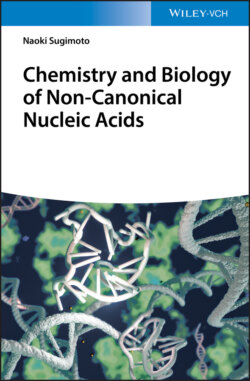Читать книгу Chemistry and Biology of Non-canonical Nucleic Acids - Naoki Sugimoto - Страница 53
3.5.2 Thermodynamic Analysis for the Intermolecular Triplex
ОглавлениеThe unfolding of the triplex-stranded DNAs is strongly dependent on the pH values of the solution medium and falls into three different groups [15]:
Under acidic conditions (less than pH 6.5)
The global triplex unfolding proceeds in a monophasic triplex-to-coil collapse
(3.16)
and the equilibrium constant, KT, can be written as
(3.17)
where SWSCSH represents the Watson–Crick–Hoogsteen triplex; ΔHT and ΔST are the van't Hoff enthalpy and entropy of triplex formation, respectively; αT is the molar fraction of the coiled strands in the structured triplex form; and CT is the total species concentration. At the maximum temperature of the derivative absorbance versus temperature curves (dA/dT vs. T), RT should be equal to ∼0.63 [16]; therefore, the van't Hoff equation can be written as
(3.18)
Under near physiological conditions (pH 7.0–7.5)
The global triplex unfolding proceeds in a biphasic triplex-to-duplex-to-single transition and can be deconvoluted into two coupled subtransitions, a Hoogsteen transition and a Watson–Crick transition,
and the corresponding equilibrium constants, KH and KWC, can be given by, respectively
(3.19)
(3.20)
where SWSC represents the Watson–Crick duplex; ΔHH, ΔSH, ΔHWC, and ΔSWC are the van't Hoff enthalpies and entropies for the Hoogsteen transition, respectively; αH is the molar fraction of the Hoogsteen strand in the structured triplex state for the Hoogsteen transition; and αWC is the molar fraction of the Watson–Crick duplex in the corresponding coiled state for the Watson–Crick transition. Although the two transitions may overlap each other in a certain range, this cross-effect can be nearly neglected at the melting temperatures, and the values of αWC and αH at which the derivative absorbance vs. temperature curves reach their maxima should be ∼0.42 and ∼0.50, respectively [17]. Thus, the van't Hoff equations can be simplified by
(3.21)
(3.22)
Under alkaline conditions (more than pH 8.0)
The triplex strand is not formed, and the complex unfolding merely includes a monophasic duplex-to-coil transition. That is,
and the equilibrium constant, KD, can be given by
(3.23)
where ΔHD and ΔSD are the van't Hoff enthalpy and entropy of duplex formation in the 1 : 1 : 1 mixture of the three strands, respectively, and αD is the molar fraction of the coiled strands in the structured duplex form. For this case, the maximum temperature should take place at αD = 0.50 [18], and therefore, the van't Hoff equation can be written as
(3.24)
